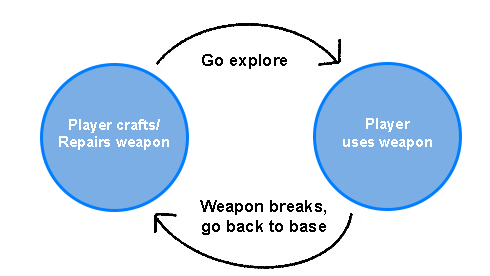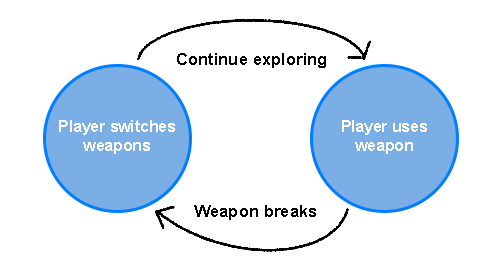Welcome to another post! When games do a weapon durability system, it often comes with two other systems: weapon crafting and weapon repair. These three systems build a nice little loop. Player crafts a weapon, uses the weapon until it runs low on durability, crafts a new weapon or repairs the old weapon, and so on. But it can be tricky to balance each of the three systems, and there aren't many ways to balance a game containing one of the above systems well without the other two pieces.
The Legend of Zelda: Tears of the Kingdom, or TotK, is one such game that feels great even though it only uses one of these systems regularly for weapons and modifies the above loop.
Durability
Durability in TotK works like durability in any other game. The more you use this weapon, the more damage it takes, and eventually it breaks.
But without the ability to craft weapons or easily repair the ones the player has, how does TotK make durability not feel frustrating?
How it works:
Basic Functions
All weapons have durability
As the weapon is struck against a physical object, it loses durability
There are special cases for ranged weapons which lose durability on use
Advanced Functions
The final strike when it breaks does double damage, and knocks back most enemies
If the weapon is thrown at the enemies’ weak points, it doubles the damage again
Makeshift weapons are easy to find and upgrade
Players can fuse weapons and shields to different objects to increase their strength, or give them an ability
If the weapons only had the basic functions like in most durability systems, it wouldn’t work. Each of the advanced functions contributes to making this system able to stand on it’s own two legs:
The final strike when it breaks does double damage, and knocks back most enemies
When a weapon breaks in games, typically it’s a frustrating scenario.
TotK warns players before this occurs, trying to prevent the frustration of having a weapon break without warning. As the durability of a weapon runs low, a text warning appears on the screen notifying the player of it. The weapon itself starts flashing red, as does the icon of the weapon in the inventory menu so the player does not forget the weapon’s state if they swapped to a different weapon. When it finally breaks, it shakes the screen as it shatters, does double damage to the enemy hit with it, and flings the foe, should they not be too large, back through the air.
And with that warning, it becomes a chance for strategic thinking, whether to try to kill an enemy with the extra damage or force them back for breathing room. Now if the player wants to escape they can, or they can press their advantage by quickly switching weapons. They can throw the weapon at a weak point to deal even more damage, or quickly swap it out if they don’t want to break it quite yet. Regardless of what the player chooses to do, they can feel that, when the weapon breaks, they have shifted the balance of the fight in their favor.
Makeshift weapons are easy to find and upgrade.
In a typical loop, most enemies wouldn't have weapons. Weapons would be random drops at best, and, more often than not, the player would need to go back and craft a new one. This creates dead time where the player needs to move away from their current objective, whether a quest or exploration. While this works fine in a more linear or smaller map, it can quickly become tedious in a massive open world game. But in TotK, so many enemies drop weapons, and makeshift weapons are scattered everywhere. So the player is always flush with basic weapons to work with. Taking this one step further, TotK respects a player's time via allowing players to upgrade very quickly in the field.
Players can fuse weapons and shields to different objects to increase their strength, or give them an ability
The fuse power allows players to quickly upgrade weapons anywhere, so long as there is something nearby to fuse to it. They can fuse one item to weapons, anything from rocks and monster parts, to tools like rockets or springs, and even other weapons. And it happens with two button presses, as long as the weapon is equipped and the item to be fused to is on the ground. This allows a player who has been hoarding monster parts to create a weapon with comparable power to the one they just lost very quickly. Or to create a tool to get up a mountain quickly. Or to create an offensive shield that shoots lasers, flames, or some equally useful projectiles. This keeps the player engaged, and allows them to continue exploring and enjoying the quest they are on. If they had a traditional upgrade system, they would need to go all the way to an upgrade hub and the player would need to break off from enjoying the world for a time.
So location based crafting is bad?
That’s not to say forcing the player to return to a specific location is bad, TotK does this with crafting food and elixirs, unless the players want to burn a Portable Pot Zoni Device. It’s just the relationship between food and elixirs to the player vs the relationship weapons have is very different.
Food’s primary purpose is to heal the player
Elixirs are to give them buffs
Weapons are to fight
If a player needs to heal, it’s because they made a mistake and got hurt, and they can cram down some uncooked food for a quick, if much weaker, healing effect. A few areas require buffs for the player to pass into, but there are clear indicators for these areas and they build on the difficulty of traversal and combat, adding an additional layer/challenge to typical exploration. The player needs weapons everywhere. Sometimes they get ambushed, sometimes they want to challenge a beast, sometimes they are just exploring a cave and find a monster nest. Without weapons, they can’t engage and pretty much need to leave. Without food, they can risk it. Without an elixir, they could also choose to risk it, trying instead to use some special mechanic such as hiding in the shadow of clouds to deal with the desert heat during the day. Weapons are required for core game engagement, food and elixirs are not. Without weapons, I’m ejected from exploring as I can no longer engage with the dangers of the world beyond running away. Because of this, it’s less frustrating to have to go back to a stable to craft food or elixirs, whereas it would be infuriating to need to do that for weapons.
Bringing it all together
So while a typical durability loop looks like this:
Zelda’s looks like this:
And it works because it is supported by a set of smaller systems and excellent reward balance which make for a uniquely fun experience.
If you enjoyed this post, you’ll enjoy Signposted my game design focused newsletter. You can sign up here: https://signposted.beehiiv.com/subscribe







